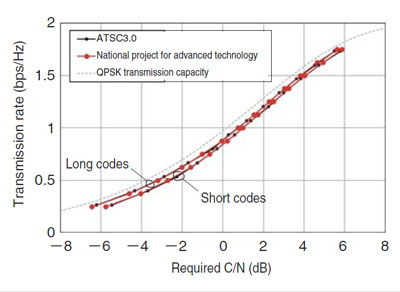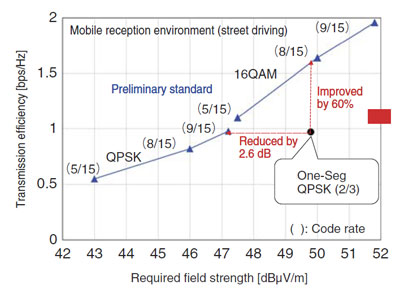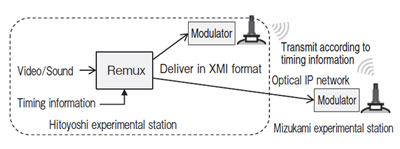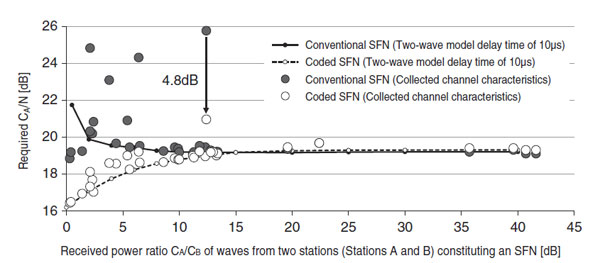Research Area
1.9 Terrestrial broadcasting transmission technology
For the terrestrial broadcasting of SHV, we made progress in our R&D on a next-generation terrestrial broadcasting system, the establishment of a large-scale experiment environment, channel planning and next-generation single-frequency network (SFN) technology. Part of this research was being performed under the auspices of the Ministry of Internal Affairs and Communications, Japan as part of its program titled “Research and Development for Advanced Digital Terrestrial Television Broadcasting System,” in cooperation with Sony Corporation, Panasonic Corporation, Tokyo University of Science and NHK Integrated Technology Inc.
■Next-generation terrestrial broadcasting system
We worked on the detailed design and performance improvement of a preliminary standard for next-generation terrestrial broadcasting. In FY 2017, we designed low-density parity-check (LDPC) codes, investigated a hierarchical transmission method, reexamined the transmission and multiplexing configuration and control (TMCC) transmission scheme and evaluated transmission characteristics of the preliminary standard through computer simulations.
Regarding the LDPC codes, we redesigned some of the 69,120-bit-length codes (long codes) that we designed in FY 2016 for the preliminary standard and also newly designed 17,280-bit-length codes (short codes). By using an appropriate (multiedge type: MET) structure for codes with a low coding rate, we demonstrated that both long codes and short codes with any coding rate (2/16 to 14/16) can achieve the same or better performance than ATSC 3.0 (Figure 1-12).
For the hierarchical transmission method, we investigated layered division multiplexing (LDM) that transmits two signals with different transmission robustness after mapping and adding them(1). We implemented a system to apply LDM to the whole signal bandwidth and a system to apply LDM only to the partial reception band into our modulator and demodulator. We also prototyped a demodulator for mobile reception that receives only the partial reception band (1.5-MHz bandwidth) and uses a sampling rate reduced to 1/4 that of a conventional device with the aim of reducing the power consumption of a frequency-division multiplexing (FDM) receiver. Moreover, as a technology for improving the characteristics, we implemented the TMCC transmission scheme using differential space frequency block codes (DSFBCs) and a frequency interleaver that performs a cyclic shift in segment units for each OFDM symbol to increase the frequency diversity gain.
Using a modulator and demodulator that we developed in FY 2016, we evaluated the reception characteristics of the partial reception band through laboratory experiments and field experiments with an STRL experimental station(2). As a result of various modifications including the use of LDPC codes for error-correcting codes, the expansion of the partial reception bandwidth to approximately 3.5 times that of One-Seg for terrestrial TV broadcasting and the provision of a longer time-interleave length option, the required field strength was reduced by 2.6 dB and the transmission efficiency was improved by 60% compared with those of One-Seg (Figure 1-13). We reflected this partial reception capability compliant with the preliminary standard in a channel coding system for sponsored research.

Figure 1-12. Relationship between required C/N and transmission rate

Figure 1-13. Comparison of required field strength between the preliminary standard and One-Seg
■Construction of large-scale experimental environment for next-generation terrestrial broadcasting
As part of the program titled “Research and Development for Advanced Digital Terrestrial Television Broadcasting System,” we prepared for setting up experimental transmission stations in Tokyo and Nagoya. In FY 2017, we designed a transmitter and developed a transmission antenna that will be used at the experimental station in Tokyo. For Nagoya, we designed two experimental transmission stations (one with the size of a main station and the other with the size of a relay station) and developed a transmission antenna for the main station and a transmitter for the relay station.
In large-scale experiments to be conducted in both areas, we plan to use signals with an extended bandwidth than that of the current terrestrial TV broadcasting. We conducted laboratory experiments to confirm the permissible values of co-channel interference and adjacent channel interference for the signals with the extended bandwidth. We investigated the co-channel and the adjacent channel protection ratios for the extended bandwidth signal through laboratory experiments. We assessed the protection ratios for the current terrestrial TV broadcasting signals interfered with by the extended bandwidth signal using 15 kinds of terrestrial TV receivers(3).
To obtain licenses in both areas, we provided the relevant broadcasters with a prior explanation of the transmission specifications of the experimental stations and their possible impact on terrestrial TV broadcasting and gained approval for the transmission specifications (Table 1-2). We applied to the Regional Bureaus of Telecommunications for an experimental station license with the goal of starting radio emission in the autumn of 2018.
Table 1-2. Transmission specifications of experimental stations

■Channel planning
Since FY 2016, we have been engaging in channel planning in cooperation with the Engineering Administration Department with the aim of enabling terrestrial SHV broadcasting that uses the same UHF band as current terrestrial TV broadcasting. In FY 2017, we studied new channels for terrestrial SHV broadcasting and frequency reallocation of existing digital terrestrial broadcasting. We reviewed selection criteria for determining the availability of channels and increased the number of calculation points, which improved the accuracy of the repacking scale estimation.
■Next-generation SFN technology
The remux equipment that we developed in FY 2016 has the capability of sending eXtensible Modulator Interface (XMI) signals that will be entered into an OFDM modulator. It therefore can control the signal output timing of the modulator according to each transmitting station’s transmission timing information, which is multiplexed with XMI packets, to enable an SFN.
In FY 2017, we conducted an SFN field experiment over an optical IP network in Hitoyoshi City, Kumamoto Prefecture. In the experiment, XMI packets sent from a remux installed at the Hitoyoshi experimental station were delivered to the Mizukami experimental station over the optical IP network. Then, OFDM signals generated by the modulators at the Hitoyoshi and Mizukami stations were transmitted from the two stations using the same frequency (UHF ch46). We confirmed at a reception point set up in a place where radio waves from the two stations arrive that video was successfully transmitted without errors in an SFN environment. We also observed the difference in the arrival time of radio waves from the two stations and confirmed the operation of the transmission timing control function (Figure 1-14).
We researched the use of space-time coding (STC) for SFN technology (coded SFN) to reduce the deterioration of transmission characteristics, which occurs when radio waves arrive from multiple transmitting stations in an SFN area. Computer simulations using channel characteristics collected in areas where an SFN is formed for terrestrial digital broadcasting showed that using the coded SFN technology can improve transmission characteristics by up to 4.8 dB even in cases where the characteristics degrade with a conventional SFN (Figure 1-15)(4).

Figure 1-14. System diagram of SFN transmission experiment

Figure 1-15. Comparison of transmission characteristics between coded SFN and conventional SFN
■International collaboration
ITU-R WP6A (Terrestrial broadcasting delivery) is preparing a report titled “Collection of field trials of UHDTV over DTT networks.” In FY 2017, we proposed adding new information about terrestrial transmission experiments using a non-uniform constellation and 8K transmission experiments in an SFN environment using HEVC/H.265 compression.
As part of research toward next-generation terrestrial broadcasting, we enrolled in the 3rd Generation Partnership Project (3GPP), which standardizes mobile communication systems, and began investigating the standardization trend of 5G. We also began a study on the use of 5G systems for broadcasting in cooperation with the European Broadcasting Union (EBU).
We visited KBS and ETRI of South Korea to investigate the situation of terrestrial 4K broadcasting, which was started on May 31, 2017, and future mobile services.
We conducted a questionnaire-based survey about emergency warning broadcasting at the Future of Broadcast Television (FOBTV), where broadcasters around the world gather, and reported the collected results at meetings of the NAB Show in April and IBC 2017 in September.
As part of activities at the Digital Broadcasting Experts Group (DiBEG), we exchanged opinions about next-generation terrestrial broadcasting with SBTVD-Forum, a standardization organization in Brazil.
| [References] | |
| (1) | A. Sato et al. (NHK): “A Study on Applying Layered Division Multiplexing for Next Generation Digital Terrestrial Broadcasting,” ITE Tech. Rep., Vol.41, No.6, BCT2016-34, pp.45-48 (2017) (in Japanese) |
| (2) | H. Miyasaka et al. (NHK): “A Study on the Partial Reception for the Proposed Specification of the Next Generation Terrestrial Broadcasting,” ITE Annual Convention 2017, 14C-3 (2017) (in Japanese) |
| (3) | N. Shirai et al. (NHK): “A study on Bandwidth Extension for the Proposed Specification of the Next Generation Terrestrial Broadcasting,” ITE Tech. Rep., Vol. 42, No. 11, BCT2018-48, pp.43-46 (2018) (in Japanese) |
| (4) | A. Sato et al. (NHK): “Transmission Performance Evaluation of SFN Technology with Space Time Coding,” ITE Tech. Rep., Vol. 41, No. 43, BCT2017-92, pp.37-42 (2017) (in Japanese) |